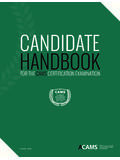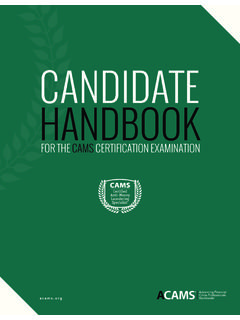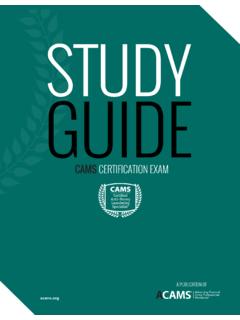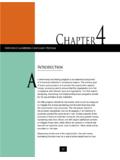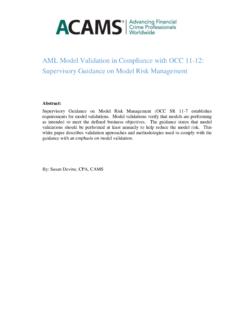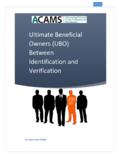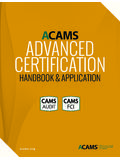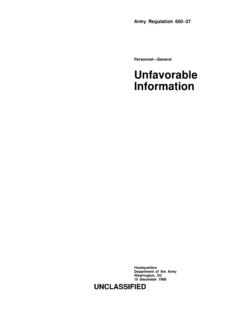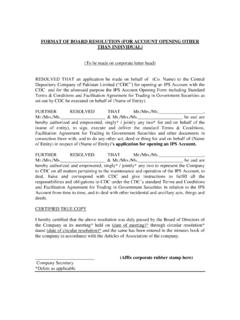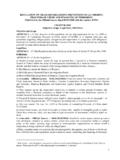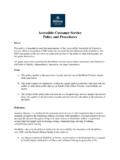Transcription of Benefits of an Effective CDD Program and How Risk …
1 Benefits of an Effective CDD Program and How Risk Scoring Customer Accounts Can Protect the Reputation of Your Firm Page 1 Benefits of an Effective CDD Program and How Risk Scoring Customer Accounts Can Protect the Reputation of Your Institution By: Douglas J. Bruggeman Benefits of an Effective CDD Program and How Risk Scoring Customer Accounts Can Protect the Reputation of Your Firm Page 2 Contents Statement of Intent: .. 3 Customer Due Diligence (CDD) .. 4 Customer Due Diligence Guidance .. 5 ABA Challenges Cost-Benefit Analysis of Customer Due Diligence Proposal .. 6 Risk Scoring .. 7 Assessing Risk and Developing a Risk-Scoring Model .. 7 Enhanced Due Diligence for Hig her-Risk C ustomers.
2 16 Conclusion: .. 17 Benefits of an Effective CDD Program and How Risk Scoring Customer Accounts Can Protect the Reputation of Your Firm Page 3 Statement of Intent: The following white paper, Benefits of an Effective CDD Program and How Risk Scoring Customer Accounts Can Protect the Reputation of Your Institution, is intended to show the importance of a formal customer due diligence (CDD) Program and how it must be designed to conform to current securities industry regulations pertaining to polici es, procedures and processes. In addition to discussing a formal CDD Program , this white paper will also discuss risk scoring a customer, including general risk scoring policies, procedures and processes.
3 Specifically, this paper will provide important guidance and information on how you can protect the reputation of securities firms and other financial institutions through discussions on the following topics: The history of CDD programs and risk scoring customers; the Benefits of Effective CDD programs and risk scoring customers; how CDD programs and risk scoring works, including examples of Effective CDD programs and risk scoring methods; problems associated with CDD programs and risk scoring customers; what and where to look for when considering solutions; and specific solutions and what actions your financial firm should consider implementing. Various resources have been relied on for this white paper to provide specific and recent information pertaining to CDD programs and risk scoring customers; Bank Secrecy Act/anti-money laundering (BSA/AML) industry regulations, poli cies, procedures and processes.
4 For further i nform ation see the bi bliography at the end of thi s docum ent. Benefits of an Effective CDD Program and How Risk Scoring Customer Accounts Can Protect the Reputation of Your Firm Page 4 Customer Due Diligence (CDD) While CDD is not explicitly required under regulations, regulatory guidance recommends that all securities firms and financial institutions have policies, procedures and processes in place that include CDD procedures to know each customer and understand the reputational risks that the customer may pose to a financial institution. A securities firm s basis of a CDD Program should be made up of four traditional elements: Customer Identification Program (CIP) Initial due diligence, Ongoing monitoring and enhanced due diligence Reporting and escalation On July 30, 2014, the Department of the Treasury s Financial Crimes Enforcement Network (FinCEN)1 issued a proposed regulation that would formalize certain requirements for how certain financial institutions conduct CDD.
5 The proposed regulation adds a CDD requirement as a fifth pillar to the traditional four-pillar AML Program requirement. Customer Due Diligence Many experts say that a CDD Program is the best way to prevent money laundering. Knowledge is what the entire anti-money laundering (AML) compliance Program is built on. The more you and your institution know, the better money laundering abuses can be prevented. 2 In addition to the four basic elements listed above, a sound CDD Program should include these seven additional elements: Full identification of customer and business entities, including source of funds and wealth when appropriate Development of transaction and activity profiles of each customer s anticipated activity Definition and acceptance of the customer in the context of specific products and services Assessment and grading of risks that the customer or the account presents Account and transaction monitoring based on the risks presented Investigation and examination of unusual customer or account activity Documentation of findings 3 An Effective CDD Program will provide securities firms and financial institutions the ability to gauge the risk presented by each customer and entity by providing the firm with a reference point for evaluating customer transactions to determine
6 Whether the transactions are suspicious and need to be reported. 1 2 3 Ibid. Benefits of an Effective CDD Program and How Risk Scoring Customer Accounts Can Protect the Reputation of Your Firm Page 5 Most securities firms and financial institutions recognize that having a strong CDD Program that goes beyond the standard CIP requirements is the basis of a solid AML compliance Program . Many securities firms and financial institutions follow guidelines found in the FFIEC BSA/AML Customer Due Diligence Overview online manual. Relevant excerpts are discussed below. CDD Guidance BSA/AML policies, procedures and processes should include CDD guidelines that: Are commensurate with the bank s BSA/AML risk profile, paying particular attention to higher risk customers; Contain a clear statement of management s overall expectations and establish specific staff responsibilities, including who is responsible for reviewing or approving changes to a customer s risk rating or profile, as applicable; Ensure that the bank possesses sufficient customer information to implement an Effective suspicious activity monitoring system.
7 Provide guidance for documenting analysis associated with the due diligence process, including guidance for resolving issues when insufficient or inaccurate information is obtained; and Ensure the bank maintains current customer information. 4 Securities firms are required by federal law to obtain and verify certain identification information from all customers as defined by the Department of the Treasury, Securities and Exchange Commission, and FINRA rules. This is commonly referred to as the CIP. The following is an excerpt from FINRA s Customer Identification Program Notice: Important Information You Need to Know about Opening a New Account:5 To help the government fight the funding of terrorism and money laundering activities, federal law requires financial institutions to obtain, verify and record information that identifies each person who opens an account.
8 This notice answers some questions about your firm's CIP. What types of information will I need to provide? When you open an account, your firm is required to collect the following information: Name Date of birth Address Identification number citizen: taxpayer identification number (Social Security number or employer identification number) 4 5 Benefits of an Effective CDD Program and How Risk Scoring Customer Accounts Can Protect the Reputation of Your Firm Page 6 citizen: taxpayer identification number; passport number and country of issuance; alien identification card number; or government-issued identification showing nationality, residence and a photograph of you.
9 You may also need to show your driver's license or other identifying documents. A corporation, partnership, trust or other legal entity may need to provide other information, such as its principal place of business, local office, employer identification number, certified articles of incorporation, government-issued business license, a partnership agreement or a trust agreement. The Department of the Treasury, Securities and Exchange Commission and FINRA rules already require you to provide most of this information. These rules also may require you to provide additional information, such as your net worth, annual income, occupation, employment information, investment experience and objectives and risk tolerance.
10 What happens if I do not provide the information requested or my identity can't be verified? Your firm may not be able to open an account or carry out transactions for you. If your firm has already opened an account for you, they may have to close it. As defined by the American Bankers Association/ABA Banking Journal, In January 2016, the ABA sent a letter to the director of the Financial Crimes Enforcement Network (FinCEN) questioning the cost-benefit analysis of FinCEN s new proposed CDD proposed rule (a) would require financial institutions to identify the beneficial owners of a legal entity who hold a 25 percent or greater ownership, including the individual who controls the entity. The ABA questions FinCEN s undertaking of the CDD rule cost-benefit analysis, where a very limited number banks and only three small institutions were included in FinCEN s sampling.


